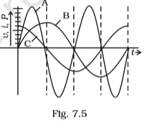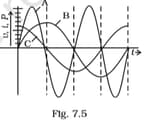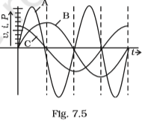NCERT Solutions for Chapter: Alternating Current, Exercise 3: SA
NCERT Physics Solutions for Exercise - NCERT Solutions for Chapter: Alternating Current, Exercise 3: SA
Attempt the practice questions on Chapter 7: Alternating Current, Exercise 3: SA with hints and solutions to strengthen your understanding. NCERT Exemplar Physics - Class 12 solutions are prepared by Experienced Embibe Experts.
Questions from NCERT Solutions for Chapter: Alternating Current, Exercise 3: SA with Hints & Solutions
A device is connected to an a.c source. The variation of voltage, current, and power in one complete cycle is shown in Fig 7.5.
(a) Which curve shows power consumption over a full cycle?

A device is connected to an a.c source. The variation of voltage, current and power in one complete cycle is shown in Fig 7.5.
(b) What is the average power consumption over a cycle?

A device is connected to an a.c source. The variation of voltage, current and power in one complete cycle is shown in Fig 7.5.
(c) Identify the device .

Both alternating current and direct current are measured in amperes. But how is the ampere defined for an alternating current?
A coil of henry inductance and ohm resistance is connected to volt, ac supply. Find the impedance of the circuit and time lag between max. alternating voltage and current.
A load is connected to the secondary of a transformer whose primary draws line voltage. If a current of flows in the load, what is the current in the primary coil? Comment on the type of transformer being used.
Explain why the reactance provided by a capacitor to an alternating current decreases with increasing frequency.
Explain why the reactance offered by an inductor increases with the increasing frequency of an alternating voltage.
